Phosphor-pumped diode laser systems deliver the high flux and the directionality, cost-effectiveness, and lifetime benefits required for applications in which LEDs fall short.
Faiz Rahman, Ohio University
The development of light-emitting diode (LED) lighting has been a great success story of our times. LEDs are nearly ideal light sources that have largely
replaced other lighting technologies, except in some niche applications. Solid-state lighting is now developing in directions such that even the few remaining areas served by discharge lamps will largely adapt to semiconductor-based light sources in the coming years.
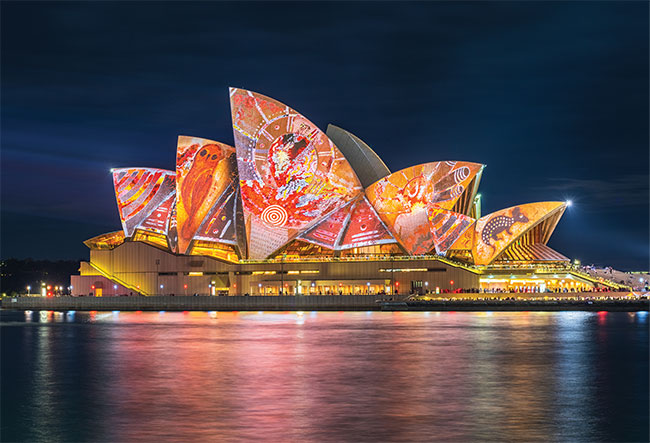
In practice, laser-diode lighting systems require a complex mix of lenses, mirrors, phosphors, and heat sinks, as well as careful system design. While this makes laser-driven lighting systems more complicated than LED illumination, the comparatively high output flux of laser technology enables much more dramatic and compelling
effects, as illustrated by the illumination of the famous Sydney Opera House. Courtesy of istock.com/Saud Nessir.
Most such applications require very high illumination intensity over a limited or extended area. LEDs are ill-suited in applications where very high output flux is the primary requirement. Examples include the illumination of building facades, stadiums, and cinema screens, where kilowatt-class lighting systems
are needed. Even the LED light engines that combine several high-powered LEDs into a single unit cannot deliver the
illumination intensity required for these demanding applications.
Laser diode-based illumination systems are ideal for such high-brilliance applications. Where LED lighting is clearly inadequate, developers are extending the technology envelope by filling the gaps with new materials and systems.
Lasers are well known as intense light sources. Even the beam from a small hand-held laser can deliver a significantly higher power density in watts per square centimeter than the midday sun.
But by themselves lasers are inappropriate for illumination. A practical laser-powered lighting system needs other components — such as lenses, mirrors, phosphors, and heat sinks — as well as careful system design with power and control electronics. These additional requirements make using a laser diode-based lighting system much more complicated than using a simple white-light LED. But for the applications that require a laser system’s power, it is well worth
the trouble.
Cooling for wavelength conversion
Light from lasers is directional, monochromatic, and coherent. Although each of these attributes is valuable for specific illumination applications, general high-brightness lighting requires white or quasi-white incoherent light. A wavelength-conversion phosphor — a luminescent material — changes monochromatic laser light into broad-spectrum light that appears white to human eyes. “White” LEDs also use phosphors, but lasers implement them differently.
The intensity of a laser beam heats luminescent wavelength-conversion
materials to very high temperatures in two ways. First, the photons that are
converted to longer wavelengths lose
energy (Stokes loss), which appears as heat. Second, the energy of absorbed, unconverted photons is dissipated as
heat. This heat degrades the phosphor
and reduces the wavelength conversion efficiency due to thermal quenching.
A high-quality heat sink manages phosphor temperature. The heat sink can be passively or actively cooled, depending on the thermal load. Also, although
LEDs generally use powdered phosphors,
single crystal phosphors — usually cerium-doped yttrium aluminum garnet (YAG:Ce) — remove heat more efficiently. Crytur, based in the Czech
Republic, produces YAG:Ce single crystals for use with high-power LEDs and laser diodes (Figure 1).
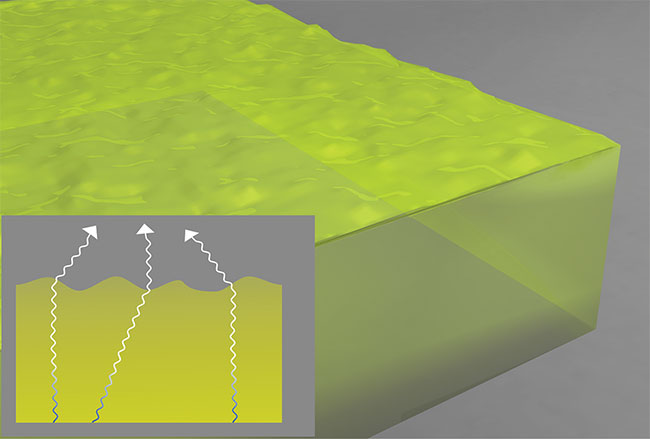
Figure 1. Single-crystal phosphor, cut from melt-grown cerium-doped yttrium aluminum garnet (YAG:Ce). The etch-roughened front surface enhances light extraction. Courtesy of Crytur spol. s.r.o..
Another, more recent, option is a composite single-crystal phosphor, which combines two materials, one for wavelength conversion and one (typically alumina) for efficient heat conduction (Figure 2). The composite option significantly improves thermal conductivity compared to a conventional phosphor. Moreover, the difference in refractive index at the interface of the two materials improves light extraction by minimizing total internal reflection. In effect, each interface becomes a channel that guides light from the interior of the crystal to
its surface. This makes the composite phosphor options especially useful with high-flux laser beams.
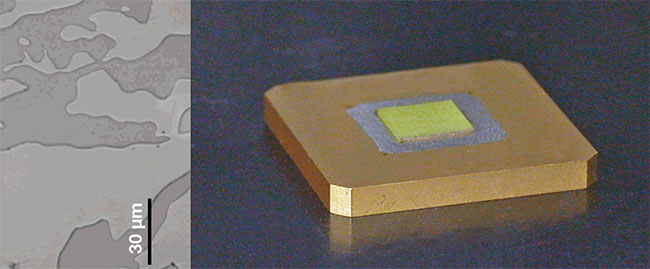
Figure 2. An alumina-YAG:Ce composite single crystal mounted on an aluminum heat sink (right). A micrograph of the composite phosphor (left), showing YAG:Ce regions (light gray) interspersed with alumina regions (darker gray). Courtesy of Oxide Corp..
Another technique that has been used in several systems is a spinning phosphor disc. The pump laser beam is incident near the edge of the disk (Figure 3). Because the disk rotates, the heated area cools before it revolves under the laser beam again.
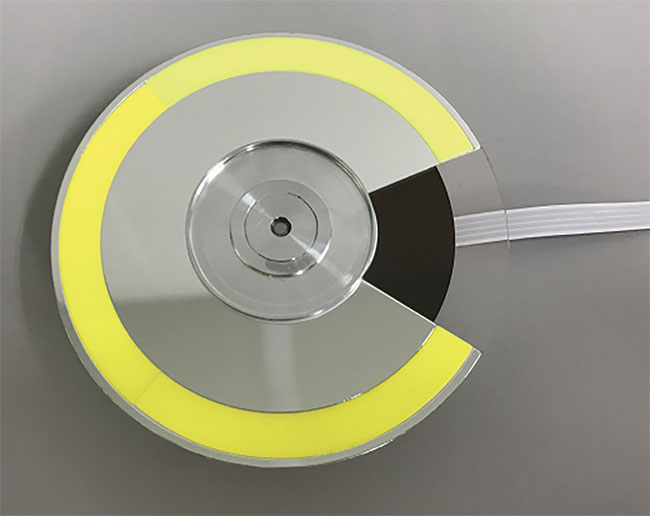
Figure 3. A phosphor wheel that spins to distribute photon and thermal load over a large area of the phosphor. Courtesy of Faiz Rahman.
The spinning technology also reduces photon flux quenching. Incident pump photons energize luminescent atoms in
a phosphor to excited energy states. The excited atom loses some energy to thermal vibrations and then de-excites to the initial energy level (ground state). Although this process is fast (usually
less than a nanosecond), the atom cannot absorb and convert photons in its excited state. If the photon flux is very high, a substantial number of photons may not
find atoms available to absorb photons
for wavelength conversion. As a result, photon conversion efficiency drops as the incident photon flux increases. The spinning-wheel approach eliminates flux quenching by constantly delivering fresh, unexcited phosphor to the area under the laser beam.
Power benefits of diode-pumped lasers
Semiconductor laser diodes (Figure 4) are the core pump sources for laser-based phosphor-converted light sources. Red laser diodes became available three decades ago, violet and blue in the 1990s, and green-emitting laser diodes several years ago.
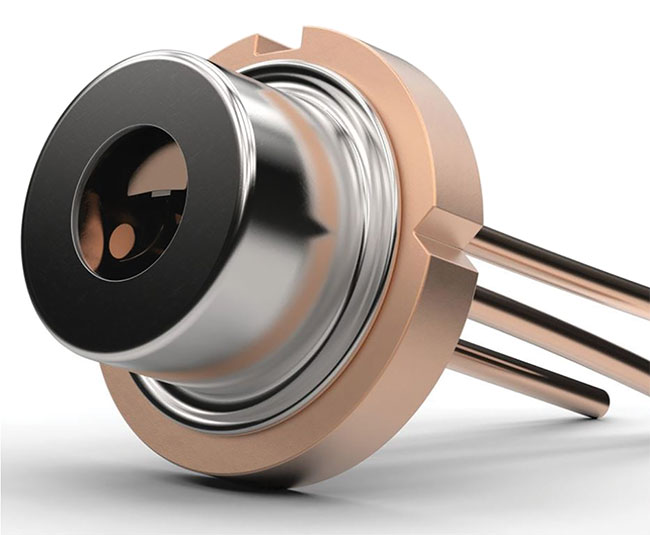
Figure 4. A typical packaged laser diode (below). Courtesy of Faiz Rahman.
The availability of laser diodes that emitted in each of the three primary colors enabled new display applications. Image displays benefit from the very
narrow spectral width of laser light emission because narrow spectral linewidths can produce more composite colors. However, space and object illumination require wide spectral coverage. Laser
luminaires, therefore, always use phosphor conversion of diode laser pump light.
With suitable phosphors, both violet (~405 nm) and blue (~450 nm) laser diodes can be used for phosphor pumping. Violet laser diodes were initially developed for Blu-ray disc players and were later joined by blue-emitting laser diodes for visible light applications. Blue-light emitters appear brighter than comparable violet-light emitters because the human eye is more sensitive to blue light compared to violet. These lasers are compatible with the phosphors used to create white LEDs, which also use blue-emitting LEDs as their source.
Manufacturers such as Nichia and OSRAM have been producing blue laser diodes of increasingly higher output powers. These devices directly contribute to the development of laser-pumped white-light systems.
For applications that need even higher pump powers, designers can use dichroics or partially reflecting mirrors to combine the output of several laser diodes. Recently developed multichip laser diode arrays also deliver high power for laser-based lighting and projection applications.
An important advantage of laser diodes over LEDs for illumination applications
is the absence of droop in device operation. LED efficiency diminishes after reaching a peak output power, even as
the drive current continues to increase. This sets a practical upper limit on how bright LED-based luminaires can be. Consequently, we may never see very bright single LEDs, such as sources equivalent to a 100-W tungsten filament bulb in light output.
Laser diodes do not suffer from droop. With appropriate device and system design, extremely high-output optical powers from watts to kilowatts are possible, which directly translates to large illuminating powers.
Laser lighting applications
The vast majority of illumination applications are well served by contemporary LED-based luminaires. In certain areas, however, laser-based lighting systems can better satisfy application requirements, and LED sources will not perform as well or at all. The intensity and/or directionality of laser beams are critical in such applications. Laser intensity is useful in applications that demand extremely high brightness. Directionality is useful in beam-forming applications in which either limited, well-defined areas need illumination, or beam power must be conserved over large distances.
Architectural lighting is an application that demands exceptionally bright light sources. Laser-based, phosphor-converted lamps are eminently suitable for this. Multilaser modules that pump a suitable phosphor subsystem deliver the power to illuminate entire building facades. With such light sources, a few high-intensity lamps can light up the exterior of even large buildings.
Another, sometimes overlooked, application is in lighting for surgical operating theaters. High-precision operations require very strong lights to maximize contrast. The lamps currently used in operating theaters are bulky because they comprise a cluster of high-intensity discharge lamps. These assemblies can be greatly simplified by using laser-powered lighting systems.
Other similar applications include aircraft runway lighting and some machine vision illumination applications.
A further, and very distinct, advantage of a laser-pumped system over one that is LED-pumped is that the light from a laser-pumped system can cover a broad spectral range. This feature improves color rendering of illuminated objects, which is essential for use in applications such as directed lighting for retail floors, museums, and art galleries. LED lamps make use of blue LEDs as phosphor pump sources. Their light does not contain wavelengths shorter than those emitted by the pump LEDs, which typically emit radiation with a peak wavelength around 450 nm. In comparison, laser diode lamp systems built with 405-nm diodes produce light that spans the entire visible spectrum. Full-spectrum radiation can accurately reproduce colors in illuminated objects. Light sources that produce spectrally rich light are coveted in applications where color and shade differences must be highly discernible.
The very high, directed light intensity from lasers also enables phosphor-converted light sources to thrive in applications that demand high directionality in addition to high intensity. These applications include searchlights, automobile headlights, and the rescue lights used by military, firefighting, and law enforcement agencies.
One of the most prominent, and now established, uses of lasers for illumination is in cine projection. Because cinema screens are so large, cine projectors
need very intense lamps. High-pressure xenon arc lamps have traditionally been used as light sources in cine projectors. These lamps are bulky, fragile, and power-hungry, and they last for only a few hundred hours before requiring
replacement. Their other drawbacks include possible explosion hazards during installation and removal, and very high thermal loads that require substantial cooling systems. Given such serious shortcomings, it is no wonder that the projection industry has welcomed the advent of alternative solid-state lamps that are superior to xenon lamps in almost every aspect.
There are two broad classes of laser-based projectors. One uses separate red, green, blue (RGB) laser diodes; the other uses phosphors to convert blue laser diode light into white light, as a direct replacement for xenon lamps. RGB laser projectors — such as the Barco XDL-4K30, a 30,000-lumen 4K-resolution large-venue projector — project bright, wide-color-gamut images because of the nearly monochromatic light emitted from laser diodes. Laser phosphor projectors, such
as the Barco F70-4K6 (Figure 5), are less expensive and use laser-excited phosphors to generate bright white, low-
divergence light for image projection. This market segment will further increase in dominance in the coming years as small home projectors, too, start using laser diode-based projector lamps.
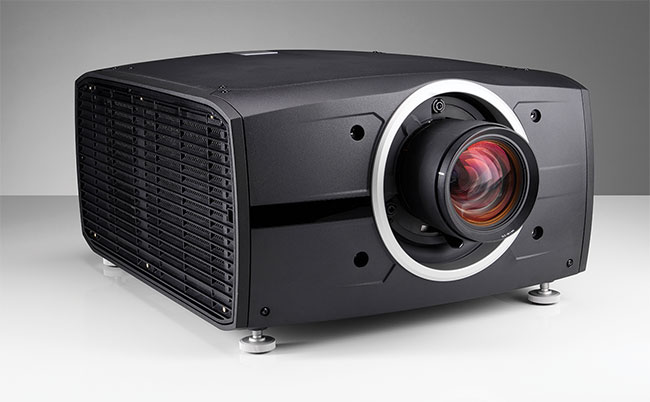
Figure 5. A Barco F70-4K6 laser phosphor projector. Courtesy of Barco Inc..
Outlook for laser luminaires
Laser diode-powered lighting has
established a firm hold in many of
the application areas where very high-intensity lighting is the prime requirement. Commercial sources and systems are now available for several applications. Design and development of laser-excited luminaires is underway for applications in which commercial systems are not yet available but are clearly highly desirable, such as architectural illumination systems and surgical lamps.
System optimization will bring down the cost of systems so that bigger markets can be tapped. For example, only a few automobile manufacturers, such as BMW and Audi, have embraced laser diode-based headlamps. However, more manufacturers will adopt them as the costs drop, as occurred during the transition from discharge-based to LED-powered headlamps in the past decade.
Overall, in the next three to five years, semiconductor lasers will become much more prominent in the lighting systems that surround us.
Meet the author
Faiz Rahman is an associate professor of
electrical engineering at Ohio University.
His research interests are in semiconductor light-emitting and light-detecting devices. He is a senior member of Optica and the Institute of Electrical and Electronics Engineers (IEEE), and a fellow of the Institute of Physics; email: [email protected].